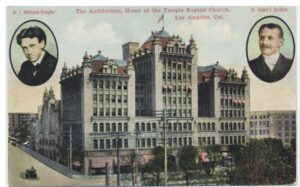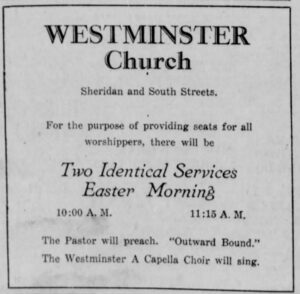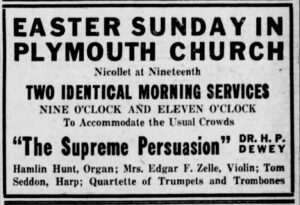When Did Multiple Services Begin?
When did evangelical churches in America begin holding multiple services?
Throughout the nineteenth century, American churches traditionally held two distinct Sunday services: one in the morning, one in the evening. On special occasions—like a building dedication—a church may have held two identical services to accommodate more people. For example, on March 25, 1900, First Methodist Episcopal Church of Los Angeles ran the same service twice for an estimated 6,000 worshippers.[1] And, of course, Roman Catholic churches often held identical masses each Sunday. But Protestant churches generally resisted the allure of multiple services. For instance, throughout the 1910s, Fifth Avenue Presbyterian Church in New York City stuck with a single service despite having to turn away thousands each Sunday.[2]
Slowly, however, this began to change. The advent of the automobile, growing urbanization, and the rise of America’s first megachurches all led to the multiple service model becoming the norm.
As far as I can tell, the first Protestant church in America to hold two identical morning services is Temple Baptist Church in Los Angeles, CA. The influential church, pastored by the theological moderate J. Whitcomb Brougher, decided on “two elaborate services in the morning” for Easter 1913. Their preacher that morning was the noted liberal and dean of the University of Chicago’s School of Divinity, Shailer Mathews.[3] The church, which gathered in the famous, 2700-seat Temple Auditorium, reportedly filled up for the occasion.

Figure 1: "The Temple Auditorium,” Home of the Temple Baptist Church, Los Angeles, CA
Churches across the denominational spectrum quickly followed Temple Baptist’s example. This was especially the case for major holidays like Christmas and Easter. For instance, Westminster Presbyterian Church in Lincoln, Nebraska, began holding “two identical services of worship” in 1927 to accommodate Easter attendance. As an article in The Lincoln Star noted:
This procedure is a novel one in Lincoln, although it is used in the larger churches on the West Coast. The arrangement has been made in order that the Easter audiences may be comfortably seated. It has been nothing unusual to turn away worshippers after the 1,100 seats have been filled and at Easter time, still larger crowds are expected.[4]
Apparently, Nebraska was trying to catch up with what was already commonplace on the West Coast.

Figure 2: Advertisement in The Lincoln Star, Apr 16, 1927:2
Churches began citing various reasons for adopting the multi-service model, but it generally stemmed from wanting to avoid turning attenders away. This was especially the case for evangelistic occasions such as Easter. In Sacramento, CA for example, Pioneer Memorial Church held identical morning services for Easter in 1928 “in order to accommodate more people, and to provide comfortable seating for all.” The pastor also explained the move in terms of convenience. He’s on the record saying, “Many people who do not find the regular 11 o’clock hour convenient will be glad of the opportunity afforded to share in the earlier service.”[5]
Trinity Church in Boston also found multiple services as a simple solution to turning away “would-be-worshippers by the hundreds.” They began holding two services for Easter in 1928.[6] The Boston Globe later reported, “For the first time in the history of Trinity Church, Copley sq, two identical services were held yesterday.”[7] Likewise in Chicago, after turning away more than 200 persons the year before, St. Luke’s Episcopal Church in Evanston began holding two Easter services in 1928.[8]
But the practice didn’t stay restricted to holidays. Other churches began holding multiple services year-round. Linwood Christian Church in Kansas City, MO, for instance, in 1924 advertised “two identical morning services, 9:45 and 11:00” where the same sermon would be preached. They boasted, “You can surely get a seat at Linwood Christian Church.”[9] In 1927, Plymouth Church began holding two morning services “to accommodate the usual crowds.”[10]

Figure 3: Star Tribune [Minneapolis, Minnesota], Sat, Apr 16, 1927:14
From the 1920s onward, American evangelical churches found multiple services to be the solution to the age-old problem of a crowded building. But the relative novelty of a practice apparently never contemplated by previous generations raises the question of what unintended consequences may have accidentally followed. Three such consequences come to mind.
1. Exceptions became the norm.
What started as an exception quickly became the norm, as more churches adopted the practice year-round. Capitol Hill Baptist Church in Washington, D.C. was no exception. Under the leadership of K. Owen White, Capitol Hill decided to hold identical services. In their case, however, the experiment was short-lived.
Temporary exigencies can necessitate short-term flexibility. But principle rather than pragmatism should determine every element of the church’s worship—especially the nature of its Sunday gathering. Before adopting a new practice, churches should always ask: what impact would this have on the church if continued indefinitely?
2. The Rise of Consumerism
There is no doubt that the multiple service model correlated with a growing consumerism in the culture. As Capitol Hill Baptist Church reasoned in 1949, “there are many who would prefer to attend an early service.” But over the course of the twentieth-century, two identical services quickly morphed into two distinct services—each designed to attract a certain demographic. Slowly but surely, church programming reinforced rather than challenged the latent consumerism of American evangelicalism.
3. A Decline of Catholicity
Along with rising consumerism, the growing practice of multiple services corresponds to the declining ties between churches in the same area. As railroad conglomerates bought up competitors, many churches seemed content to reflect the cultural sentiment that bigger was better. But what if these churches had recognized the constraint of their gathering space as a God-given push to plant other churches? Or encourage attendees to attend other gospel-preaching churches closer to their homes? Would better models of pastoral leadership have developed if, instead of an arms-race, churches had been content to stick with a single service?
Beyond these possible consequences, the practice of multiple services raises further questions about the nature of the church, the role of the gathering in the life of the church, and the responsibilities of members before God toward those they rarely, if ever, gather with. More than 100 years into the American church’s experiment with multiple services, these questions remain unanswered.
* * * * *
[1] “Beauteous Church” in The Los Angeles Times, 26 Mar 1900:10
[2] New-York Tribune. 13 Feb 1915:11.
[3] “Big Pulpit Program” in Los Angeles Evening Express, 22 Mar 1913:4.
[4] “Church Planning Double Services Easter Morning” in The Lincoln Star, 6 Apr 1927:2.
[5] “Pioneer Church Plans Two Easter Services, Identical, In Forenoon” in The Sacramento Bee, 23 Mar 1928:20.
[6] “News From the Churches” in Edmonton Journal [Edmonton, Alberta, Canada], 24 Mar 1928:8.
[7] “Hundreds Turned Away in Back Bay” in The Boston Globe, 09 Apr 1928:8
[8] “Easter Services Call 2,500,000 to Church Today” Chicago Tribune, 8 Apr 1928:16.
[9] Advertisement in The Kansas City Star, 4 Oct 1924:4.
[10] Advertisement in The Minneapolis Journal, 14 Apr 1927:19.








